
I. Introduction
Weight loss can be a tough uphill battle, but it’s not impossible. One of the best ways to shed those extra pounds is by hitting the gym. However, going to the gym and not knowing what to do can be daunting and unproductive. This article aims to help you make the most out of your gym sessions by providing you with tips and advice on what to do to lose weight.
II. Focus on Cardio
If you’re looking to lose weight, cardio is your best friend. Cardio exercises such as running, cycling, and swimming are excellent at burning calories, which can help you shed weight. The American Heart Association recommends doing at least 150 minutes of moderate-intensity cardio exercise per week to maintain a healthy weight.
One great way to incorporate cardio into your gym routine is by using machines such as treadmills, ellipticals, or stationary bikes. Using machines can also help you track your progress and monitor the number of calories burned.
Don’t forget to mix up your cardio routine every once in a while to prevent boredom and plateauing. Try new exercises like jumping jacks, burpees or jump rope. Incorporating high-intensity interval training (HIIT) can also help increase the intensity of your workout which will lead to more calories burned.
III. Incorporate Strength Training
Strength training is important for weight loss because it helps build muscle. The more muscle you have, the more calories you burn at rest. Weightlifting or bodyweight movements such as push-ups and squats can help you build muscle. Aim for working out all the major muscle groups of your body twice a week.
Make sure to start with lighter weights and then gradually progress to heavier ones. Doing too much too soon can result in injuries. Also, remember to incorporate proper form and breathing techniques. If you’re unsure about where to start, consider hiring a personal trainer as they can assess your fitness level and put together a personalized program.
IV. Make A Workout Schedule
Creating a workout schedule will help you stay accountable, consistent, and balanced. It’s essential to have a workout plan that includes both cardio and strength training exercises. You can also set specific goals like jogging for 30 minutes without stopping or bench pressing a particular weight. Choose exercises that you enjoy so that you don’t get bored and give up quickly.
You should also make sure to incorporate rest and recovery days into your workout schedule. Overtraining can lead to burnout, injuries, and can slow down weight loss progress. On rest days, consider doing some light yoga, stretching, or walking to help with muscle recovery and flexibility.
V. Mix Up Workouts
Doing the same workouts over and over again can get monotonous and lead to plateauing. Incorporating different workouts can challenge your body and help you shed those extra pounds. You can try signing up for new gym classes that you’ve never tried before, like kickboxing, dance classes or yoga. Or perhaps you could try outdoor activities like hiking, swimming, or cycling.
To stay motivated while trying new workouts, set a specific goal that you want to achieve and share it with a workout buddy or accountability partner. Doing so can help create a sense of healthy competition and encouragement. Additionally, keep track of your progress to monitor your improvement and keep yourself motivated.
VI. Track Progress
Tracking progress is essential for weight loss because it helps you see the changes or improvements happening in your body. There are a few ways to track progress from taking photos at regular intervals, taking body measurements, or logging your weight. Taking photos or measurements can help you track changes in body fat percentage and muscle mass. Logging your weight can give you a general idea of how much weight you’re losing or gaining. It’s important to remember that progress takes time, so don’t get discouraged if you don’t see results immediately.
VII. Don’t Forget About Nutrition
A healthy diet is just as important as regular exercise when it comes to weight loss. Eating a balanced diet including lean protein, healthy fats, and whole grains can help aid weight loss. Avoid snacking on processed foods like chips, candy, and soft drinks. Instead, plan for healthy snacks like fresh fruits, veggies, or protein bars.
Meal planning is also an excellent way to ensure you’re eating healthy meals consistently. Planning your meals in advance can help you avoid unhealthy food options and save time. You can also try tracking your calories or macronutrients to ensure that you’re eating enough and keeping your diet balanced.
VIII. Stay Motivated
Staying motivated is essential when it comes to weight loss. Surround yourself with people who support and encourage your fitness journey. Consider finding a workout buddy or joining fitness groups. Another great way to stay motivated is by celebrating small victories. Achieving small goals like running for an extra five minutes without stopping is worth celebrating and can help keep you motivated.
Make sure to remind yourself of your weight loss goals regularly. You can try hanging up motivational quotes or reminders on your fridge or setting alarms to help you stay on track. Consistency, patience, and determination are the keys to achieving your weight loss goals.
IX. Conclusion
We hope that this article has provided you with helpful tips and advice on what to do at the gym to lose weight. Remember to focus on cardio, incorporate strength training, make a workout schedule, mix up workouts, track progress, don’t forget about nutrition, and stay motivated. Losing weight can be challenging, but with discipline, consistency, and effort, you can achieve your fitness goals.




